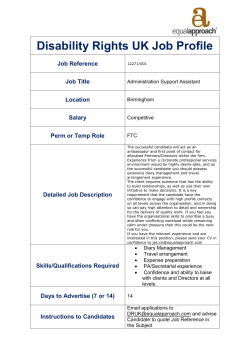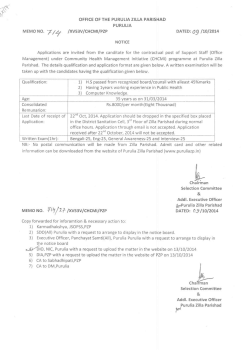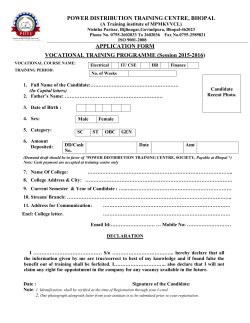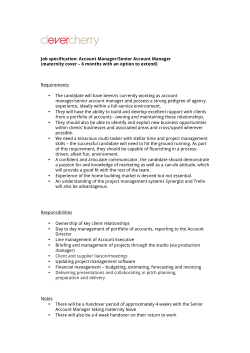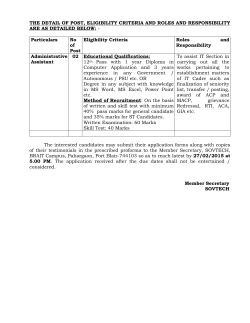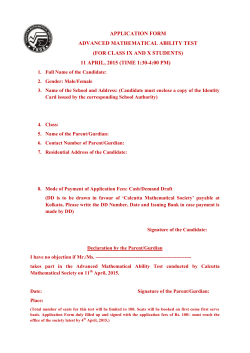
Call Letter - Office of the Provost
May 20, 2015 PROMOTION AND TENURE CALL For Actions Effective 09-01-2016 Note: The entire document has been reformatted and some information has been reordered to match outline standards. Highlights indicate changes in content only. This is the formal call for applications for promotion and/or tenure to be effective September 1, 2016. One paper and one electronic copy of each dossier must be submitted to the Office of the Provost on December 1, 2015 by the dean of a school or college. Please consult your Dean’s Office or school/college guidelines for prior deadlines. Dossiers can be delivered to the attention of Kirsten Malinee in the Office of the Provost, 114 Jesse Hall. SUPPLEMENTAL MATERIALS AVAILABLE ON THE PROVOST’S OFFICE WEB PAGE The documents listed below are available on the Provost’s Office web page: http://provost.missouri.edu/faculty/tenure.html. 1. 2. 3. 4. 5. 6. 7. 8. Recommendation Signature Page Joint Appointment Recommendation Signature Page Appointment History Dossier Checklist Sample Five-Year Appointment History Table Sample Course Evaluation Table Course Evaluation Blank Table Suggested Wording of Request to Outside Reviewers (initial email and formal follow-up letter) 9. Procedures for Selection of Outside Reviewers 10. Sample External Evaluator List 11. Table of Due Dates 12. Dossier Presentation and Procedures for Paper and Electronic Submission 13. Visual Guide for Electronic Folder Arrangement 14. P&T Call Document (REVISED) 15. P&T Guidelines from the University of Missouri Collected Rules & Regulations THE PROMOTION AND TENURE DOSSIER: I. POLICY AND PROCEDURE REMINDERS Candidates for promotion and/or tenure and all faculty, staff, and administrators involved in the promotion and tenure process should review Section 320.035 of the University of Missouri Collected Rules and Regulations (CRR): http://www.umsystem.edu/ums/rules/collected_rules/faculty/ch320/320.035_policy_and_ procedures_for_promotion_and_tenure This section of CRR contains detailed information about many aspects of the P&T process, including the following: 1. joint appointments 2. committee membership in units with few tenured professors 3. solicitation of additional evaluative information from within and outside the University 4. levels of review 5. appointment, election, designation of various promotion and tenure committees 6. role of teaching, research and creative activity, and service 7. notification process As a supplement to the policies identified in CRR 320.025, please note: No individual should vote more than once on a case. For example, a faculty member on a divisional P&T committee should abstain at either the department or division level. Deans and department chairs make a recommendation and include a letter in the dossier; consequently, they should not vote at any level. For purposes of P&T a joint appointment is defined as having a regular instructional or research appointment, with a specified set of responsibilities, in a second unit (department, school, or college) whose faculty (a) were involved in the decision to offer a joint appointment, and (b) are authorized by the Collected Rules and Regulations to vote on recommendations for tenure and promotion pursuant to unit guidelines. The Provost requires that department committees have at least three members. CRR 320.035A.1.d identifies eligible appointees to department committees in cases where there are fewer than three eligible faculty available to serve from the primary department. II. IMPORTANCE OF DOSSIER PREPARATION As one of the nation’s leading teaching and research institutions, MU maintains high standards in recruiting, promoting, and awarding tenure to faculty. The campus goal is to ensure continuous quality improvement in teaching, research, and service. Satisfaction of minimum criteria at the department, college, and university levels is not sufficient to ensure promotion or tenure. Judgments are based upon evidence of sustained Page2of13 productivity, excellence, and potential for future contributions to the University. A candidate’s total contribution to the major missions of the University should guide faculty votes. Promotion and tenure recommendations are subjected to rigorous and thorough examination at each ensuing level of review. The dossier is the primary source of information for judging the candidate’s contributions and future potential. It must contain evaluations of performance in teaching, research and service by each level of review for the tenure-granting department and the joint appointment department (if any), as well as evaluations of research by external reviewers. The materials in Tabs I, II, III, and VII are to be supplied by departmental committees, Chairs, and Deans. This includes any materials associated with appeals. Any explanatory addenda to the required forms are to be signed by the author. The candidate is presumed to be the author of all materials included in Tabs IV, V, VI, and VIII. If materials in those Tabs are authored by someone other than the candidate, the individual’s name should be included along with the date. The Department Chair is responsible for ensuring that the dossier is complete before it is forwarded to the next level of review. Each school must designate a person in the Dean’s office to complete a Checklist to verify that: 1. All electronic files are in .pdf format. 2. All electronic files can be opened. 3. All pages and scans are upright and in order. 4. Scanning should be done after all letters have been added and all signatures and votes included. 5. The paper copy and the electronic version are complete and identical. The Checklist should be signed by the person who verified the contents and should be included as Pages 3-4 in the paper copy. III. SELECTION OF AND COMMUNICATION WITH EXTERNAL REVIEWERS Units must select a set of qualified reviewers from appropriate academic institutions (such as AAU peer public universities) who can provide objective reviews. Units may also nominate and select additional reviewers from non-academic institutions and / or current/recent collaborators of the candidate who are qualified to provide an expert objective review. Any external reviewers who are selected to provide reviews of some aspect of a candidate’s work other than his or her research or creative activity (e.g., extension or clinical practice) must be balanced by ones directly addressing the candidate’s research or creative activities. A. Criteria for External Reviewers from Academic Institutions External reviews of the candidate’s achievements in research and scholarship Page3of13 must be objective and of high quality. Each external reviewer should meet these criteria: 1. Tenured full professor with an explanation provided if this is not possible 2. Expert of documented national stature in a field closely associated with some facet of the candidate’s work 3. Affiliated with a reputable academic institution with a degree program comparable to that of the candidate’s department 4. Able to provide an unbiased review. Reviewers who might reasonably be viewed as biased should not be nominated; this likely includes, but is not limited to collaborators, Ph.D. advisors, postdoctoral mentors, former classmates, and former colleagues at MU or at other universities, and book reviewers of a candidate’s product. B. Criteria for External Reviewers from Non-Academic Institutions / Collaborators 1. An expert (preferably doctorally-prepared) of documented national stature in a field closely associated with the candidate’s work 2. Affiliated either with a reputable non-academic institution with a mission pertinent to the candidate’s work or an academic institution 3. Able to comment upon the impact of the candidate’s work upon the field. C. Number of Review Letters A minimum of six and no more than eight letters, on letterhead, are required. However, all letters received must be included. No more than two letters can be from reviewers at non-academic institutions. D. External Reviewer Nomination and Selection Process 1. The candidate should give the Chair a list of mentors and other individuals who would have difficulty writing an objective review. 2. The candidate should also provide names of potential reviewers (candidate nominees). 3. In a separate process, departmental faculty should provide names of potential reviewers, according to departmental processes. 4. About half of the nominations for reviewers can be made by the candidate and half by the department, excluding individuals with personal ties to the candidate. 5. The final selection should be made only by the department chair or department P&T committee (divisional chair/committee where there are no departments). 6. More than eight potential reviewers can be selected and prioritized so that others can be contacted if any nominees decline to serve. 7. At least half of reviewers selected should be departmental nominees. 8. If no one from the candidate’s list is selected, the Chair must provide an explanation to the candidate and include the explanation in the dossier. E. Contacting Nominated Reviewers and Providing the Candidate’s Materials Page4of13 1. Chairs are advised to contact potential reviewers by e-mail to verify availability and willingness to provide a review before sending materials. A sample email has been provided. 2. The formal request letter to reviewers (http://provost.missouri.edu/faculty/ReviewerFollowUpLetter.doc) must include: a. the candidate’s percent effort in each mission for the most recent academic year b. a request for the reviewer to state whether and how they know the candidate and if they know the candidate, the reason(s) they can provide an objective review c. a request for comments on i. overall level of creativity and the impact of the research ii. the potential for future productivity iii. the extent of development of a national/international reputation 3. The following can be requested at the unit’s discretion: a. An assessment of teaching, service, and / or Extension b. A comparison of the candidate’s achievements with peers known to the reviewer c. An evaluation of whether the candidate meets the specified standards of his/her department at MU for promotion and / or tenure (not whether the candidate meets the standards at the reviewer’s institution) 4. All reviewers should receive the same materials. In disciplines with a different practice, the Chair should provide an explanation in the dossier. 5. Whenever possible and if the reviewer is amenable, provide materials in electronic format. Reviewers should receive: a. The follow-up letter (detailed above) b. The candidate’s CV c. The candidate’s “Statement of Research/Scholarly Accomplishment” d. Copies (pdfs or reprints) of appropriate publications or links to those materials e. CDs or DVDs of creative works or links to those materials f. Department and university guidelines for promotion and/or tenure g. Other materials at the unit’s discretion 6. Reviewers should not receive any mentor or peer reviews of the candidate’s credentials or any documents from prior levels of review. 7. Reviewers should be asked to supply: a. A signed letter on letterhead b. A CV or bio-sketch, to be retained by the department, not for inclusion in the dossier F. Sharing External Letters with Candidates In some units external letters are shared with the candidate; in others they are confidential. The department or chair should notify referees whether or not letters are kept confidential. Page5of13 IV. CONTENTS OF THE DOSSIER The dossier should contain only the materials listed below and outlined in the form Presentation of Promotion and Tenure Dossiers. The dossier is divided into sections, called Tabs in the hard copy and Folders in the electronic copy. These sections are as follows: Pages 1 and 2: Pages 3 and 4: Tab/Folder I: Tab/Folder II: Tab/Folder III: Tab/Folder IV: Tab/Folder V: Tab/Folder VI: Tab/Folder VII: Tab/Folder VIII: Recommendation Signature Page Appointment History Form Dossier Checklist Appointment Folder Unit Procedures and Recommendation Letters College/School Recommendation Letters Procedural Summaries The Complete CV Teaching/Scholarship of Teaching Research/Scholarship External Reviews Service and/or Administration Detailed information about these sections is provided below. Pages 1 and 2: Recommendation Signature Page and Appointment History Form Page 1 is the either the Recommendation Signature Page or the Recommendation Signature Page for Faculty with Joint Appointments. In cases with joint appointments, the primary unit is typically specified as the tenure home or tenureawarding unit, although faculty and chairs of both units are involved in the tenure and promotion process. The primary department (tenure-granting unit) is responsible for initiation of the dossier and for forwarding the dossier for review to the joint-appointment unit. Regardless of which form version is used, the following must be recorded by each level of review: (a) yes/ no; (b) a numerical vote, if applicable; and (c) a signature. The numerical vote recorded for a department should be the vote of all eligible voting faculty, not that of a subcommittee making a recommendation to that group. Page 2 is the Appointment History Form (http://provost.missouri.edu/forms/history.doc). A completed sample is available at http://provost.missouri.edu/faculty/samplehistory.pdf. If necessary, an addendum, written by the Chair, should explain any variations in percentages over the last five years and any differences in percentages due to appointments such as grants, leaves, summer appointments, or administrative duties. Pages 3 and 4: Dossier Checklist Page6of13 The Dossier Checklist is included to ensure all items required are included in both the hard copy and the electronic copy of the candidate’s dossier. The checklist should be filled out and signed by the person in the dean’s office who is responsible for verifying that the dossier is complete. Tab/Folder I. Appointment Folder 1. The initial letter of appointment (for any candidate going through his/her first promotion/tenure process at MU) 2. For tenure candidates, the departmental third-year (mid-probationary) review letter OR an explanatory letter from the Chair if such a document does not exist. 3. For tenure candidates to whom it applies, the Provost’s letter approving an extension of the probationary period 4. For tenured faculty, the five-year post-tenure review(s) Do not include annual reviews, departmental approvals of probationary extensions, or notification letters of prior promotions or award of tenure. Tab/Folder II. Unit Procedures and Recommendation Letters A. Letters and Summaries from Faculty and the Chair of the Tenure-Granting Unit and the Joint-Appointment Unit if any. Refer to Section I: Policy and Procedure Reminders for the definition of joint appointment. 1. The complete set of departmental guidelines for promotion and tenure 2. Recommendation letter from the departmental promotion and tenure committee, which can include departmental procedures cited in Tab II. 1. above. The letter must also include: a. Numerical results of all formal votes before and after hearings b. List issues relevant to outcomes of votes if such issues were discussed at the meeting c. Any known explanation for split or dissenting votes or majority negative votes d. See 3.h. below for comments needed by the department committee and/or chair concerning disagreement with external review letters and negative votes. e. A recommendation with rationale 3. Recommendation letter from the Chair. Both the department’s letter and the Chair’s letter should include: a. An overview of the candidate’s accomplishments, especially while at MU b. Any exceptions to requirements specified in department P&T guidelines must be explained c. Any deviations from the expectations cited in the appointment letter or midprobationary review should be explicitly explained in some detail. d. Generally accepted standards of quality within the discipline, both on this campus and nationally (e.g., basic vs. applied research, archival journal articles vs. case reports) e. Interdisciplinary relevance of the work, if applicable, and an evaluation of the interdisciplinary work Page7of13 f. An appraisal of the quality of outlets where the work has appeared g. An overview of institutional support received (e.g., start-up funds, release time, internal grants), and appropriate expectations for achieving external funding h. Comments on any differences of opinion in letters of external reviewers i. Comments on why the recommendations of the department committee or chair differ or why either of those two levels disagree significantly with any of the external review letters, if applicable. The letters from the departmental promotion and tenure committee and/or department chair should briefly describe issues discussed in meetings of the committee or the departmental faculty. This is particularly important when there are a substantial number of negative votes, regardless of whether the final recommendation was positive or negative. j. For promotion to professor, appraisal of achievements in teaching and research since the last promotion and appraisal of service contributions expected at that rank (department-level, campus-level, off-campus service at the national level) 4. Comments from tenured faculty of the unit concerning a candidate’s contributions 5. Recommendation letter from the Division Director (if applicable) 6. Report of the process, votes, and issues from an appeal at any level. This can be done in a separate letter. Include copies of handouts provided by the candidate at hearings and any other materials submitted by the candidate that were used in the decision-making process. A. Letters from Faculty, Chair/Director/Supervisor of the Following, as Applicable: 1. Tenure-awarding units in which the candidate has a documented “joint appointment” and contributes to the teaching or research mission of that unit, but does not have a specific percent of effort assigned to that unit 2. Programs/ Centers with which the candidate is affiliated, having a designation such as “core faculty” or “faculty member” 3. Unit(s) in which the candidate has a designated “courtesy appointment” Tab/Folder III. College/School Recommendation Letters; Procedural Summaries A. Letters from college/ school (divisional) promotion and tenure committees should include 1. Numerical results of all formal votes (before and after hearings) 2. Issues relevant to outcomes of votes if such issues were discussed at the meeting 3. Any known explanation for split or dissenting votes or majority negative votes 4. A recommendation with rationale B. Recommendation letter from the Dean incorporating 1. An overall evaluation of the candidate’s work, including interdisciplinary work 2. Any special circumstances that should be considered 3. A perspective on any differences of opinion at prior levels of review 4. A clear statement of the reasons for the recommendation Page8of13 Tab/Folder IV. The Complete CV In the CV, tenure candidates should emphasize teaching, research, and service achievements since the appointment at MU. Candidates for promotion to professor should emphasize such achievements since the last promotion. The CV should not exceed 25 pages in length. Tab/Folder V. Teaching/Scholarship of Teaching A. Summary of teaching achievements, incorporating these sections 1. The candidate’s teaching philosophy, no more than one page in length. 2. Teaching responsibilities at MU with most recent items listed first. 3. Use of instructional technology (as applicable) 4. Noteworthy teaching-related accomplishments, including grants, awards, and honors. 5. Overview of publications and presentations concerning teaching (if applicable) B. The completed Course Evaluation Table (http://provost.missouri.edu/faculty/sample-evaluation.html) for each course taught or team-taught since MU appointment (for tenure candidates) or since the last promotion. Do not substitute other forms. 1. Specify the scale dimension (e.g., teaching effectiveness) reported for each course. 2. For each course, the department must provide the departmental average for courses at that level, the evaluation average, course GPA, etc. Each cell in the table must be completed for each course and is essential information to evaluate the reliability of student evaluations. If there are no departments, aggregate data to the school/college level. 3. When the scale changed from 5.0 to 4.0, show the result as X/4.0 for those semesters. 4. Below the table, the candidate is to write a paragraph interpreting trends in data (i.e., perceived reason(s) for changes in ratings over time, with different courses/levels of courses, and adjustments/changes in teaching methods/approaches. C. A summary and evaluation of student advising 1. For each student or post-doctoral fellow, provide names, dates of attendance, any grant support provided by the candidate, student awards or recognitions, the degree awarded and the date, and current position, if known. This information should be placed in Folder V., Sub-Folder C in the electronic copy of the dossier. 2. List undergraduates, MS, PhD, and post-doctoral students separately. Explain post-doc advising, if any. 3. For graduate students, specify thesis/dissertation adviser or committee member. D. Peer reviews of teaching are required by campus policies. These reviews should not be letters of endorsement written for the dossier. They should not be evaluations written by students (or former students). They should be peer reviews collected on a systematic basic across time intervals and involving class visits, reviews of teaching materials, or whatever is prescribed at the unit/college level. This applies for Page9of13 promotions to Professor as well as the tenure decision and promotion to Associate Professor. At least two, but no more than four peer reviews of teaching representing different semesters and different courses, if possible. 1. Peers should assess teaching style and faculty-student interaction in the classroom or on-line, as well as aspects of course design. 2. Departmental peers should comment on contributions to departmental teaching. 3. For candidates for professor, include only peer evaluations done since the last promotion. E. Description of involvement in campus-wide teaching and student engagement initiatives (Examples: Campus Writing Program, General Education, Honors College, FIGS). F. If applicable, a description and evaluation of Extension activities, with detailed evidence of quality. Numerical evaluations should be summarized in brief tables and data interpreted. Tab/Folder VI. Research/Scholarship Tab/Folder VI should contain three documents (described in the more detail below): a statement of scholarly accomplishments, a bibliographic list of publications, and details on grants. Do not include examples of scholarly work in the dossier. Instead retain such examples, such as pdf copies of scholarly articles and sound files or slides of creative work at the department, available to the Campus Promotion and Tenure Advisory Committee and Provost upon request. A. The candidate’s description of scholarly accomplishments (no more than three pages). 1. Describe how the scholarly work can best be understood in disciplinary and interdisciplinary contexts. 2. Assess the current and projected impact of the research in the field. B. The bibliographic list of all types of scholarly products, with the most recent first, including those in press, those accepted for publication, or e-prints ahead of publication. 1. Scholarly products or creative activities should be listed under separate headings for pre-MU and post-MU appointment. For promotion to Full Professor, such products should also be separately listed under pre-tenure and post-tenure headings. Scholarly products should also be separated under different headings by books, peer reviewed articles, non-peer reviewed articles, book chapters, conference proceedings, conference presentations, etc. 2. If there are publications with multiple authors, publication references should appear with authors listed in the order that they appear in the journal, an explanation of the protocol for listing the order of authors must be included. Additional information about authors and contributors may also be indicated (e.g. undergraduate student contributor, graduate student contributor, etc.). At the end of the citations for each publication with multiple authors, describe the candidate’s contribution to the work in term other than percent of effort. Page10of13 3. After each citation, include two indicators of outlet quality determined by departmental consensus (i.e., manuscript acceptance rate; impact factor; ranking from a specific, stated source). 4. Papers submitted but not accepted for publication should be listed separately under the list of published and in-press manuscripts. 5. A separate list of non-referred publications (clearly indicated as such) should also be included. 6. Refereed and non-refereed conference presentations and proceedings, lists of performances and exhibitions, and citations of published reviews of performances and exhibitions are to be included as relevant to the candidate’s scholarly work. C. Details on grants: Include the name of the project, type of grant, funding agencies, collaborators, the candidate’s role, contribution, total funding, dates, salary coverage, and whether students received support from the grant. Tab VII / Folder VII. External Reviews A. Description/list of the unit’s specific criteria for external reviewers, if any B. Description of nomination and selection process for this candidate’s reviewers. Include: number of reviewers nominated by candidate, department committee, and chair respectively 1. selection process and who was involved in it 2. procedures used to contact reviewers (e-mail) 3. explanation of reason(s) given by each nominee who declined the e-mail invitation 4. explanation of situations involving persons who agreed to review did not provide a letter 5. process used to select additional reviewers, if necessary. C. The completed “Procedure for Selection of Outside Reviewers” form: http://provost.missouri.edu/forms/selection.doc. 1. List reviewers in alphabetical order by author’s name and specify (only) the academic institution with which they are affiliated. 2. Indicate who nominated and selected each reviewer. 3. Within the list include names and affiliations of persons who (1) did not respond to the initial contact, (2) declined to serve, and (3) initially agreed to serve but did not send a letter. D. A summary of reviewer biographies. Biographies should be included only for reviewers who submit letters. (sample at http://provost.missouri.edu/faculty/sample-list.html ). The summary must include this information about each reviewer: 1. Current position, rank, and academic affiliation 2. The particular qualifications of the reviewer that were the reasons for his/her selection, in relation to the foci or methods of the candidate’s research 3. Justification for selecting a reviewer who did not meet one or more of the criteria for reviewers specified in this call [Section II.A, Criteria 1-4] 4. Whether / how the reviewer knows the candidate (based on the reviewer’s report) Page11of13 E. An example of the e-mail sent to invite a scholar to consider serving as an external reviewer. F. An example of the formal invitation letter to persons who agreed to serve as reviewers G. Every letter (or other evaluative correspondence about the candidate’s dossier) received from any and all reviewers. Reviews may not be excluded for any reason after being received. Tab/Folder VIII. Service and/or Administration A. The candidate’s overall description of service responsibilities should be listed with dates under separate headings (as relevant) such as: 1. Departmental service 2. Division/College service 3. Service to the MU Campus 4. Service to the UM System/ Extension service for persons without an Extension appointment 5. Extent of participation in state, regional, national and international professional associations. 6. Editorial and refereeing responsibilities. 7. Relationships among the candidate’s service activities, teaching responsibilities, and research program 8. Solicited letters evaluating service contributions may be included, but no more than three. V. REQUEST FOR RECONSIDERATION A candidate who receives a negative recommendation at any point in the multi-step process may request a hearing for reconsideration at that level. Unless otherwise stated, hearings will be before the person or committee making the recommendation that has been challenged. If a recommendation is reversed after reconsideration, the rationale must be explained. Regardless of the recommendation at any point in the process, the dossier will move forward to the next level unless the faculty member wishes to withdraw from the process. Any materials used in the hearing process should be included in the Tab for that level of review. Copies of written documents presented at hearings with the Campus Promotion & Tenure Advisory Committee also will be included in the dossier and shared with the appropriate dean’s office. VI. UPDATING THE DOSSIER After submission of dossiers to the Office of the Provost, candidates are encouraged to update their information. For example, word may be received of a grant awarded or a manuscript accepted for publication. Such information should be submitted to the Provost and the Dean’s Office simultaneously for insertion in the appropriate dossier. Updates Page12of13 should be dated and labeled with the appropriate Folder/Tab number and include the updated information only. Any updated information must be submitted to Kirsten Malinee in the Office of the Provost (malineek@missouri.edu) in electronic format (PDF) to facilitate circulation to the campus committee members. Page13of13
© Copyright 2025
